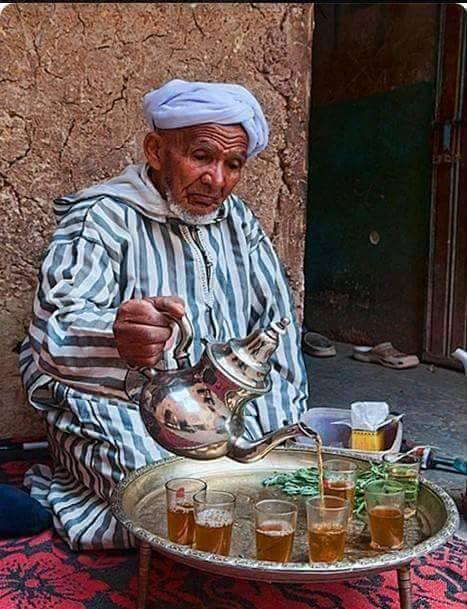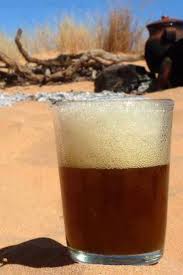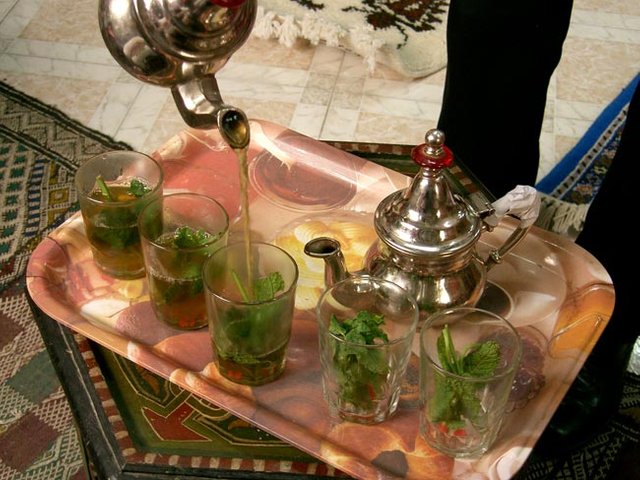الشاي المغربي # Thé marocain # Moroccan tea
الله الله على الشاي المغربي

و لايمكن ان تدخل الى منزل مغربي و لا يوضع لك الشاي في المائدة
اذا كان الصينيون هم اول شعب اكتشف الشاي، فالمغاربة هم من ابدعوا في تحضيره وتذوقه، وجعلوا له طقوسا احتفالية، لا تقتصر على المناسبات والاعياد فقط، بل أصبحت جزءا من الحياة اليومية. فالشاي او «اتاي» بالعامية المغربية، يحضر طوال النهار، وفي جميع الاوقات سواء في الصباح الباكر، او حتى في ساعة متأخرة من الليل، على الرغم من انه منبه قوي
والشاي عند المغاربة قبل ان يكون مشروبا يوميا، هو ايضا وسيلة للترحيب بالضيوف، اذ لا يمكن ان تدخل بيتا سواء كان اهله من الفقراء او الاغنياء، الا وسارعوا الى إحضار صينية الشاي، اذ يعتبر من قلة الذوق أن يحل بالبيت ضيف ويذهب الى حال سبيله من دون ان يتناول كأس شاي

ويقال إن الشاي دخل الى المغرب للمرة الاولى خلال القرن الثامن عشر، في عهد السلطان المولى اسماعيل، الذي تلقاه هدية من الاوروبيين

ولعل اول ما يلفت الانتباه في طريقة إعداد الشاي على الطريقة المغربية، هو جمالية الادوات المستعملة لتحضيره وتقديمه، فالصينية والبراد (الابريق) مصنوعان من معدن الفضة الخالصة، او من معدن مشابه له، والخاصية المشتركة بينهما هي اللمعان، كما ان الصينية تكون مزينة بنقوش يدوية، وكذلك الشأن بالنسبة «للبراد»، الذي يتخذ شكلا فريدا وشامخا، لا نجده في أي بلد آخر، وتعد مدينة فاس المنبع الرئيسي لأدوات الشاي، حيث حافظ الحرفيون على هذه الصناعة التقليدية التي تحمل بصمة اندلسية، تدل على البذخ والفخامة
وترافق الصينية والبراد،ادوات اخرى يطلق عليها «الربايع» وهي ثلاث علب من نفس المعدن، تكون مخصصة للشاي والسكر والنعناع

اما بالنسبة لكؤوس الشاي، فتلك حكاية اخرى لا تقل سحرا وجمالية، ذلك أنها تكون مزخرفة وملونة بالاخضر والاحمر والاصفر، وتصف فوق الصينية بعدد لا يقل عن خمسة كؤوس حتى وان كان الضيف شخصا واحدا، اذ من غير اللائق ان يوضع عدد محدود من الكؤوس في الصينية
ويطلق المغاربة اسماء معينة على هذه الكؤوس، مثل كأس «حياتي»، وهي كأس صغيرة الحجم من الزجاج الشفاف، للاستعمال اليومي، اما كأس «البلار» فهي كأس ملونة غالية الثمن
ولتحضير مذاق مميز للشاي المغربي، لا يتطلب مزج عناصره بطريقة اعتباطية، بل لا بد من اتباع طريقة لا يجيدها الا المحترفون، في البداية يتم وضع ملعقة من الشاي في «البراد» ويصب عليها قليل من الماء المغلي، ثم يسكب في كأس ويحتفظ به، وتسمى هذه العملية «التشلال»، ثم يصب قليل من الماء مرة ثانية على حبات الشاي، ويسكب دون الاحتفاظ به، ثم تعاد الكأس الاولى الى براد الشاي، ويملأ بالماء المغلي، ويضاف اليه بضع قطع من سكر «القالب»، وهو سكر تقليدي ايضا له شكل مخروطي، ويترك على النار لاستكمال الغليان، وتسمى هذه العملية «التشحير»، وفي الاخير ينزل من على النار ويضاف اليه النعناع الطري حتى يحتفظ بنكهته
ولا يكتفي المغاربة بإضافة النعناع فقط الى الشاي، بل يتفننون في إضافة عدد من الاعشاب الطبيعية المنسمة، وتسمى «التخليطة»، وتباع عند بائعي النعناع، وهي فليو، مرددوش، السالمية، الحبق ومانتا
لا يتخد الشاي المغربي مذاقا واحدا طوال العام، بل لكل فصل مذاق خاص. ففي فصل الشتاء، تستعمل نبتة طبيعية اخرى بديلا عن النعناع، تسمى «الشيبة» وتمنح للشاي مذاقا مختلفا، اما في فصل الربيع، فتستعمل ازهار البرتقال مع النعناع، وهذا المزيج يعطي نكهة خاصة جدا للشاي، فتفوح منه رائحة زكية
وهناك ايضا من يستغني عن إضافة أي اعشاب منسمة للشاي، ويضيف اليه السكر فقط، وهي طريقة خاصة بأهل الصحراء، حيث يتميز الشاي بمذاقه المر اللذيذ ولونه القاتم، ويصلح تناوله بعد وجبة دسمة جدا، باعتباره وسيلة هضم جيدة
لا يقتصر اعداد الشاي على الطريقة التقليدية في المنازل فقط ، فالمقاهي الشعبية لها طقوسها ايضا، اذ يقدم الشاي للزبائن في كؤوس كبيرة الحجم مزدانة بالنعناع الطري،يأتي بها النادل غير موضوعة فوق صينية كما هو معتاد، بل معلقة في دوائر مصنوعة من الحديد، يمسكها مثل البندول، يرتشفها الزبائن بتلذذ الى آخر قطرة، وهم يتجاذبون اطراف الحديث

ومن طقوس تقديم الشاي عند المغاربة ايضا ان يقدم مرفقا بالحلويات التقليدية مثل «كعب غزال» و«البريوات» و«الغريبة»، الا ان الشاي يتناسب مع جميع أصناف الحلويات والفطائر، والخبز ايضا، فوجبة الخبز والشاي شهيرة في المغرب لانها مشبعة، ووسيلة سهلة لاسكات مغص الجوع
في الماضي كان إعداد الشاي يحتاج الى جلسة خاصة، وكانت هذه المهمة تسند للرجل سواء في المناسبات، او داخل البيت، حيث كانت الزوجة تحضر أدوات صنع الشاي الى الزوج او كبير العائلة، الجد مثلا، الذي يجلس فوق فرش على الارض، في صالة الضيوف، وامامه الصينية و«البراد»، فيشرع في اعداد الشاي على مهل، يقلبه اكثر من مرة

اما الآن فلا احد لديه الوقت الكافي لمثل هذه الطقوس الا في حالات استثنائية مثل المناسبات والاعياد، إذ اصبح الشاي يحضر بسرعة فائقة في المطبخ ويقدم جاهزا، الا ان هذه العملية مسموح بها لاهل المدن فقط، اما في القرى فتقديم الشاي بتلك الطريقة، يعبر عن قلة ذوق، وعدم احترام للضيوف، الا ان بعض العائلات المغربية العريقة ما زالت محافظة على تقاليد اعداد الشاي، ولم تتنازل عنها أبداً، وهناك من يحتفظ بأدوات صنع الشاي قديمة جدا، حيث كانت من بين الهدايا الثمينة التي تقدم للعروس من طرف عريسها
فالشاي مشروب قومي لدى المغاربة، ورمز سياحي ايضا، يوظف في كثير من الاعلانات التي تروج للسياحة في البلد المعروف بالكرم والضيافة
و من اهم الاعلانات اعلان ريدوان الموزع الموسيقي المغربي
المصدر يوتوب

Si les Chinois sont les premiers à découvrir le thé, les Marocains sont créatifs dans leur préparation et leur goût, et en ont fait une célébration solennelle, qui ne se limite pas aux événements et aux festivals, mais qui fait partie de la vie quotidienne. Le thé ou «Atai» dans le langage familier marocain est présent tout au long de la journée, en tout temps, tôt le matin, ou même tard le soir, bien qu'il soit un puissant stimulant.
Thé quand les Marocains avant d'avoir un verre par jour, est aussi une façon d'accueillir les invités, car il ne peut pas entrer dans une maison, que ses habitants sont pauvres ou riches, cependant, et se sont empressés de mettre en place le plateau de thé, car il est le manque de goût pour remplacer l'invité de la maison et aller à des chemins différents de Sans avoir à prendre une tasse de thé.
On dit que le thé est entré au Maroc pour la première fois au 18ème siècle, pendant le règne du sultan Moulay Ismail, qui a reçu un cadeau des Européens.
Peut-être la première chose qui attire l'attention sur la voie du thé sur la marocaine, est les outils esthétiques utilisés pour préparer et soumettre, réfrigérateur Vachinah (aiguière) vérifier, argent métal pur, ou en métal semblable, et la propriété partagée entre eux clignotent, et les Chinois sont décorées avec des sculptures en main , ainsi que le cas «à Brad», qui prend une forme unique et se tient debout, ne se trouve pas dans un autre pays, il est la ville de Fès, la principale source de thé, où il a gardé des artisans de cette industrie traditionnelle portant l'empreinte andalouse, ce qui indique l'extravagance et le luxe.
Avec le chinois et le brad, d'autres outils appelés "spring", trois packs du même métal, sont dédiés au thé, au sucre et à la menthe.
En ce qui concerne les tasses de thé, est une autre histoire de pas moins de charme et esthétique, ils sont décorés et colorés en vert, rouge, jaune et décrit sur le nombre chinois au moins cinq tasses, même si l'invité était une personne, car il est inapproprié de mettre un nombre limité de tasses en chinois .
Les marocains appellent des noms tels que Hayati Cup, une petite tasse en verre de verre transparent, pour un usage quotidien, tandis que la Coupe est une coupe colorée.
Pour préparer le goût du thé marocain distinctif ne nécessite pas de mélange arbitraire éléments, mais doivent suivre la voie non maîtrisé, non seulement le professionnel, est mis d'abord une cuillerée de thé dans «réfrigérateur» et versez un peu d'eau bouillante, puis verser dans la tasse et le garder, et appelé ce processus «Altfall», puis quelques verse de l'eau à nouveau sur les pilules de thé, et versez sans la retenir, la première tasse retourné à thé Brad, rempli d'eau bouillante, et l'ajouter à quelques morceaux de «moule» de sucre, un sucre traditionnel a aussi la forme Cone, et laissé sur le feu pour terminer l'ébullition, appelé ce processus «diffamation», et enfin descendre du feu et ajouter La menthe est si douce qu'elle garde sa fraîcheur.
Marocains ne se contentent pas ne font qu'ajouter à thé à la menthe, mais Atvennon pour ajouter un certain nombre d'herbes naturelles Almnsmh, appelé «Altkhalith», vendus lorsque les vendeurs de menthe, un VLAO, Mrdduc, Salmiya, basilic et Manta.
Le thé marocain ne goûte pas une année entière, mais chaque saison a un goût particulier. En hiver, utilisez un autre substitut végétal naturel pour la menthe, appelée «Shaiba» donne le goût du thé différent, que ce soit au printemps, fleurs d'oranger Vtstaml à la menthe, et cette combinaison donne une saveur très spéciale de thé, Vtvouh il odeur.
Il est dispense également avec l'ajout d'un thé Mnsmh à base de plantes, lui ajoute que le sucre, ce qui est particulièrement le peuple du désert, où le thé se caractérise par Bmmagah amer savoureux et la couleur façon sombre, en forme de manger après un repas est très crémeuse, comme une bonne façon de digérer.
Thé la façon traditionnelle est non seulement dans les maisons seulement, Valmqaha populaires ses rituels aussi bien, car il offre le thé aux clients dans les grandes tasses décorées avec de la menthe douce, venez par le serveur est placé sur le plateau comme d'habitude, mais suspendu dans les cercles sont en fer, maintenu comme Le pendule, grésillé par les clients jusqu'à la dernière goutte, ils ont bavardé.
Il est un rituel du thé quand marocain propose également un centre comme «talon Ghazal» traditionnelle et «Albruat» et «exotique», mais des bonbons de thé en rapport avec toutes les variétés de bonbons, pâtisseries, pain, aussi, du pain Fujbh célèbre thé au Maroc car il est saturé, facile et des moyens Pour supprimer la colique de la faim.
Dans le passé, la préparation du thé nécessitait une session spéciale, et cette tâche était assignée à l'homme à la fois et à la maison.La femme apportait les outils de fabrication de thé au mari ou à la grande famille, le grand-père, par exemple, Sa mère chinoise et le «frigo», et il commence à faire du thé lentement, en le retournant.
Maintenant, personne n'a le temps pour de tels rituels, sauf dans des cas exceptionnels tels que les occasions et les fêtes.Le thé est introduit très rapidement dans la cuisine et prêt à être préparé, mais ce processus est autorisé seulement aux gens des villes. Goût et manque de respect pour les invités, certaines familles marocaines maintiennent toujours la tradition de la fabrication du thé, n'abandonnant jamais, certains des outils de fabrication du thé sont très anciens, parmi les précieux cadeaux donnés à la mariée par son fiancé.
Le thé est une boisson nationale pour les Marocains, et est aussi un symbole touristique, qui est utilisé dans de nombreuses publicités faisant la promotion du tourisme dans le pays connu pour sa générosité et son hospitalité.

If the Chinese are the first people to discover tea, the Moroccans are creative in their preparation and taste, and have made it a ceremonial celebration, not limited to events and festivals only, but became part of daily life. Tea or "Atai" in Moroccan colloquialism is present throughout the day, at all times, in the early morning, or even late at night, although it is a powerful stimulant.
And tea before the Moroccans before it is a drink daily, is also a way to welcome guests, as can not enter the house, whether the poor or rich people, but quickly brought to the tea tray, as it is a lack of taste to solve the house guest and go to the case of Without having to take a cup of tea.
Tea is said to have entered Morocco for the first time in the 18th century, during the reign of Sultan Moulay Ismail, who received a gift from the Europeans.
The first thing to draw attention to in the way of preparing tea in the Moroccan way is the aesthetic of the tools used to prepare and present it. The Chinese and the jug are made of pure silver metal or similar metal. The common characteristic is the gloss. The Chinese are decorated with hand engravings , As in the case of the "Pradad", which takes a unique form and is not found in any other country, and the city of Fez, the main source of tea tools, where the artisans kept the traditional industry, which bears an imprint of Andalusia, show the extravagance and luxury.
Along with the Chinese and the brad, other tools called "spring", three packs of the same metal, are dedicated to tea, sugar and mint.
As for tea cups, this is no less magical and aesthetic story, as it is decorated and colored in green, red and yellow, and describes the Chinese at least five cups even if the guest one person, it is inappropriate to put a limited number of cups in Chinese .
Moroccans call names such as Hayati Cup, a small glass cup of transparent glass, for daily use, while the Cup is a colorful cup.
In order to prepare a distinctive taste of Moroccan tea, it does not require mixing the ingredients in an arbitrary way. Rather, it is necessary to follow a method that is not only good for the professional. At first, a teaspoon of tea is placed in the fridge and a little boiling water is poured over it. The process is then "poured out", then a little water is poured over the tea beads, poured without retaining it, the first cup is returned to the tea fridge, filled with boiling water, and a few pieces of sugar are added. Cone, and left on the fire to complete the boiling, called this process «defamation», and finally come down from the fire and add The mint mint is so soft that it keeps its mint.
Moroccans not only add mint to tea, but also add a number of natural herbs, called "confection", and are sold to mint sellers, Feliu, Mardadouche, Salmiya, Habak and Manta.
Moroccan tea does not taste a whole year, but every season has a special taste. In the winter, another natural plant is used as a substitute for mint, called chiba. Tea is given a different taste. In the spring, orange blossoms are used with mint, which gives a very special flavor to the tea.
There is also the need to add any herbal tea, and add sugar only, a method for the people of the desert, where the tea taste bitter and tasty dark, and can be eaten after a very heavy meal, as a means of digestion good.
Tea is not only traditional in homes. Popular cafes also have its rites. Tea is served to customers in large cups filled with soft mint. The waiter comes not on top of a tray as usual, but hangs in iron-made circles. The pendulum, sizzled by customers to the last drop, they chatted.
The tea rite is also suitable for all types of sweets, pies, and bread. Bread and tea are popular in Morocco because it is saturated and is an easy way to drink. To suppress hunger colic.
In the past, the preparation of tea required a special session, and this task was assigned to the man both on occasions and in the house. The wife brought the tea making tools to the husband or the great family, the grandfather, for example, His Chinese mother and the "fridge", and he starts to make tea slowly, turning it over.
Now, no one has time for such rituals except in exceptional cases such as occasions and holidays. Tea is brought in very quickly in the kitchen and ready to be prepared, but this process is permitted only to the people of the cities. Taste, and disrespect for guests, some Moroccan families still maintain the tradition of tea making, never giving up. Some of the tea-making tools are very old, among the precious gifts given to the bride by her groom.
Tea is a national drink for Moroccans, and is also a tourist symbol, which is used in many advertisements promoting tourism in the country known for its generosity and hospitality.
AJ picked your post @digi5952 for his #TOP5 FOOD POST. Visit AJ's FOOD ROUNDUP to view where your post is ranked.
Thanks
شاپو ليك
Merci bcp @sweever
الله على أتاي ديالنا ، ا على ديك الصينية كتشهي، انا هنا كنتسقرم عليه حيت مكينش هنا، كنجيبو معايا ا كنديرو فالتلاجة.
Hhhhhh fach ikhassak goliha lina nsiftoh lik mrahba